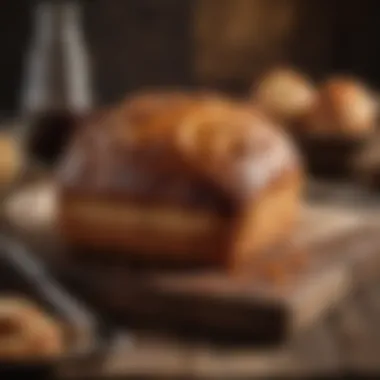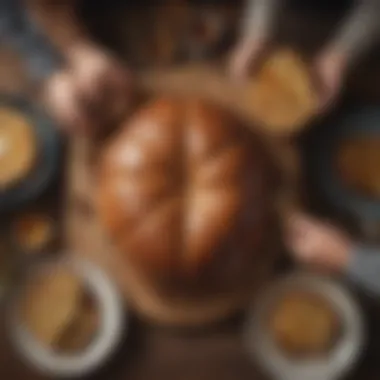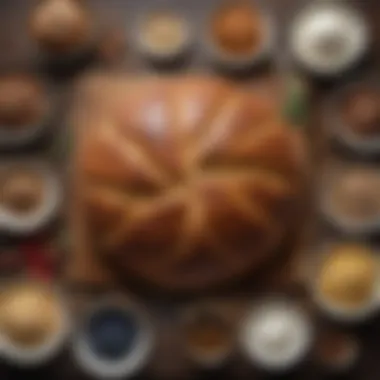Exploring the Intricacies of Friendship Bread


Intro
Friendship bread is more than just a recipe; it embodies a tradition rich with history and personal connection. This unique culinary phenomenon serves as a bridge between the act of baking and the nurturing of friendships. When you share a loaf of friendship bread, you are not merely passing along food but also an opportunity for connection, warmth, and shared experiences. It creates a rhythm through which people engage, share stories, and fortify their bonds.
In our fast-paced lives, we sometimes overlook the simple joy of cooking with others. Friendship bread invites us to slow down, observe, and appreciate both the ingredients and the people involved in the process. As the bread rises and browns, so too do relationships flourish, nourished by collaboration and shared effort. This article explores the journey of friendship bread, from its roots to its contemporary relevance, we will also unwrap its recipe intricacies, ingredient particulars, and how it transcends cultures.
Not just a culinary endeavor, friendship bread bears psychological significance, having the potential to elevate interpersonal relationships and foster a sense of community. Whether it’s a starter you share with friends or a personal venture into baking, it’s the connections formed along the way that highlight the depth of this experience.
Historical Context of Friendship Bread
Understanding the historical context of friendship bread provides a profound glimpse into how this unique culinary tradition has evolved over time. Not merely a recipe, it stands as a testament to community bonds, sharing, and the fusion of culinary artistry with human connection. This blend of social and culinary practices captures the imaginations and appetites of food lovers of all ages, linking past and present in a meaningful way.
Origins of Friendship Bread
The story of friendship bread likely has its roots in the age-old practice of bread-making that can be traced back thousands of years. The literal act of baking bread symbolizes nurture and sustenance, serving as a metaphorical thread tying people together. Yet, what sets friendship bread apart is its distinct element of sharing—an act that transforms a simple loaf into an expression of camaraderie.
In American households, the concept of friendship bread emerged prominently in the late 20th century, particularly popularized by a recipe for a starter dough that is passed from one friend to another. This chain, known as a "starter", creates a sense of continuity and community; the idea is akin to the old saying, "it takes a village." Each loaf made from the starter or shared amongst friends carries a story, a memory, or a gesture of goodwill. Hence, friendship bread transcends just being a recipe; it acts as a medium for socialization and shared experiences.
Cultural Variations Throughout History
As with many foods, friendship bread shows remarkable versatility across cultures, adapting to local tastes and customs. In many societies, sharing food is a cultural norm, and bread often occupies a sacred place in these traditions.
- In Europe, for instance, sourdough cultures have been passed around generations. In Italy, the concept of sharing dough mirrors the communal meal traditions, where bread symbolizes togetherness and hospitality.
- In the Middle East, pita bread and other staples are often made and shared during gatherings, reinforcing connections in familial and communal settings.
- In the United States, the modern variant of friendship bread has integrated various cultural aspects, combining ingredients and flavors, welcoming diverse culinary influences, and making it a melting pot of historical influences.
This array of cultural variations illustrates that friendship bread, while unique in its practice, is a universal concept that bridges gaps and brings people together, both in its making and in its sharing. As recipes travel and evolve, they retain the spirit of their origins while fostering new relationships and community networks.
Understanding the Essence of Friendship Bread
Friendship bread transcends simple baking; it embodies the spirit of connection and community. This unique culinary tradition is not just about flour, sugar, and yeast, but rather about the bonds formed while creating and sharing it. Understanding the essence of friendship bread reveals its multifaceted nature, blending both culinary and social aspects. As we delve deeper, we grab an idea of how it nurtures relationships, fosters connection, and reflects cultural identities.
Defining Friendship Bread
Friendship bread is more than a mere recipe; it is a living, breathing practice that evolves with every loaf shared. At its core lies a sourdough-like starter, which is often passed from one friend to another. The starter, a blend of flour, water, sugar, and occasionally yeast, ferments over time. This process not only produces bread but also symbolizes the nurturing of relationships. The act of receiving a starter carries an unspoken commitment to care for it, much like nurturing a friendship. When one bakes and shares their friendship bread, it’s part of a larger narrative—sharing love paired with a delicious treat.
Symbolism and Social Significance
The act of making and sharing friendship bread is loaded with meaning. Each loaf serves as a reminder of the importance of community and trust. Here's how:
- Culinary Legacy: Friendship bread connects generations. An older family member passing down the starter signifies the transfer of love and tradition.
- Acts of Kindness: It’s more than just food; it represents an invitation to connect. By sharing friendship bread, one can reach out during tough times, celebrating joys or offering comfort during grief.
- Community Building: Especially in times of isolation, baking and sharing this bread can rekindle local connections. Neighborhood gatherings centered around friendship bread can foster new friendships and strengthen old ties.
"Sharing food is a universal language that transcends barriers; friendship bread speaks volumes in its simplicity."
Overall, friendship bread embodies the essence of togetherness, transforming mundane moments into cherished memories while simultaneously highlighting the intricate dance of social bonds woven through culinary traditions. As we continue to explore, it will become increasingly clear just how much a humble loaf can mean in the context of human connection.


Starting the Dough: The Process of Making Friendship Bread
Starting the dough is arguably where the magic of friendship bread truly begins. This stage holds significance not only for the end product but also for the connections it fosters. Baking this bread is more than simply following a recipe. It’s about sharing an experience that intertwines culinary art with the essence of friendship.
As you embark upon the journey of making friendship bread, you become part of an age-old tradition where the act of sharing and nurturing is front and center. Similar to planting a seed and watching it grow, each step in the process symbolizes hope, community, and the joy of collaboration. Understanding the specifics is vital for anyone with an eagerness to connect through food, as each ingredient serves a purpose far beyond mere taste.
Ingredients and Equipment Needed
To begin your friendship bread adventure, gather the necessary ingredients and tools. Here’s what you’ll need:
- Ingredients:
- Equipment:
- 1 cup of all-purpose flour
- 1 cup of sugar
- 1 cup of milk
- 1 packet of instant yeast
- A pinch of salt
- Optional flavorings such as cinnamon or vanilla
- Mixing bowl
- Measuring cups and spoons
- A wooden spoon or spatula
- Bread loaf pan
- Plastic wrap
When collecting these items, aim for quality over quantity. Fresh ingredients not only enhance flavor but also contribute to a successful starter, ensuring your friendship bread rises beautifully.
Step-by-Step Preparation Guide
Once you have your ingredients and equipment ready, you can dive into the preparation. Here’s a straightforward guide to getting started:
- Combine Dry Ingredients: In a mixing bowl, whisk together the flour, sugar, yeast, and salt. This ensures an even distribution throughout the dough.
- Add Wet Ingredients: Gradually pour in the milk, and mix with a wooden spoon or spatula until fully blended. The dough should form a sticky ball.
- Kneading: Transfer the dough onto a lightly floured surface and knead it for about 5 to 10 minutes. You're aiming for a smooth consistency without any lumps. Kneading builds gluten, which is what gives the bread its chewy texture.
- Let it Rise: Form the dough into a ball and place it in a greased bowl. Cover it with plastic wrap and let it rise in a warm spot until it approximately doubles in size—this usually takes 1 to 2 hours.
- Shaping and Second Rise: Once risen, punch down the dough to release air bubbles and shape it into your desired form. Place it in the loaf pan, cover, and allow it to rise again. This time, it should take about 30 minutes.
By following these steps, you're not just making bread; you're initiating the expansive social network that surrounds this culinary delight.
Nurturing the Starter: A Living Entity
In many ways, the starter for friendship bread is reminiscent of a relationship—it needs care and attention. Think of it as a living entity that will respond to your effort and intention. Here are some important considerations for nurturing your starter:
- Regular Feeding: Just as friendships require nurturing, so does your starter. Every few days, add flour, sugar, and milk to keep it active. This keeps the yeast lively and robust.
- Monitor the Environment: Keep an eye on your starter's environment. It thrives best in a warm place but should be shielded from direct sunlight. Too hot or too cold, and it might become sluggish.
- Use It Often: The cycle of sharing and baking can create an ongoing relationship with your starter. Once it’s been nurtured and is bubbling with activity, use it in baking projects, gift it to friends, or create variations to explore new flavors.
By paying attention to these aspects, you empower both your culinary and social skills, ensuring that friendship bread continues to be a symbol of togetherness and joy as long as it exists in your kitchen.
Variations of Friendship Bread Recipes
Friendship bread is not just a standard loaf; it embodies adaptability and personal flavor. The variations of friendship bread recipes illustrate how this culinary tradition evolves, allowing bakers to express their creativity while maintaining the core principle of sharing. Each twist on the classic recipe invites both novice and seasoned bakers to explore the joy of baking and the relationships that develop alongside it.
Classic Friendship Bread Recipe
The classic friendship bread recipe forms the backbone of this cherished tradition. Made primarily from a sourdough starter, flour, sugar, and milk, it receives its distinctive sweetness and tenderness from the starter that has been lovingly nurtured over days. The process, while straightforward, allows for plenty of individual flair. One might choose to add nuts or spices, but the real magic unfolds when it's shared with friends. Not merely a baked good, it symbolizes nurturing — both of the starter and of relationships. Here's a simple overview of the classic recipe:
- Ingredients: 1 cup of starter, 1 cup of sugar, 1 cup of flour, 1 cup of milk, and crucially, the love and care you add yourself.
- Process: Feed the starter for 10 days, then mix the rest of the ingredients, bake, and voilà! A loaf ready for sharing.
Creative Flavors and Ingredients


Once you have conquered the classic recipe, the real fun begins. Creative flavors and ingredients can turn your basic friendship bread into a unique treat. This section digs into three popular options that breathe new life into the traditional loaf.
Fruit Enhancements
Adding fruits to friendship bread is a delightful way to enhance its moistness and flavor. Common options include bananas, apples, and raisins. Each fruit not only enriches the taste but also changes the texture notably, making the bread denser or lighter, depending on the choice.
Key Characteristic: Fruits amp up the natural sweetness and can dramatically alter the moisture level. Bananas, for example, create a moist bread that many find irresistible.
Benefits: Using fruits makes the bread feel more healthful, as they introduce vitamins and nutrients. Additionally, a fruit-enhanced loaf can spark conversations about favorite flavors and childhood memories tied to baking.
"The best gifts are often those that tell a story, and incorporating fruit adds a personal touch to each loaf of friendship bread."
Spice Infusions
Spice infusions bring an aromatic twist to friendship bread, allowing bakers to experiment with flavors ranging from cinnamon and nutmeg to cardamom and ginger. Each spice offers a unique flavor profile that can transform the basic recipe.
Key Characteristic: Spices do not merely add flavor but also evoke feelings and memories tied to comfort and home. The scent of cinnamon can whisk one away to a cozy kitchen on a winter afternoon.
Advantages: Spice-infused bread brings warmth and depth, encouraging a sensory experience that goes beyond just taste. The downside is that too much spice can overpower the delicate friendship bread essence, so timing and measurement come into play.
Nuts and Chocolate
Incorporating nuts like walnuts or pecans gives friendship bread a lovely crunch, while chocolate chips or cocoa powder introduce a rich, indulgent flavor. Pairing these two elements can lead to delightful contrasts of texture and taste.
Key Characteristic: Nuts add not just flavor, but also nutritional value, providing protein and healthy fats. Chocolate brings a touch of decadence that appeals to a wide range of taste buds.
Benefits: This combination can transform the friendship bread from a simple treat to a gourmet delicacy, ideal for celebrations or casual gatherings. However, one must consider allergies — not everyone can partake in nutty goodness, pushing bakers to strike a balance.
In sum, friendship bread's variations invite both exploration and community engagement. Whether you're opting for fruity enhancements, spicing things up, or indulging in the richness of nuts and chocolate, each choice helps create a baking story worthy of sharing.
Social Dynamics of Sharing Friendship Bread
The act of sharing Friendship Bread is layered with significance, transcending mere culinary preparation. It operates as a social glue that fosters connections, deepens relationships, and nurtures a sense of community. Understanding this dynamic spectrum enriches our appreciation for the tradition, reminding us that the baking process is not just about the end product but also about the relationships built through it. The simple act of passing along a starter becomes a ritual in itself, akin to giving a piece of oneself to another.
Building Relationships Through Baking
At its core, baking friendship bread is an invitation. It encourages interactions among diverse groups — friends, family, and even strangers. When a loaf is gifted, it opens doors to conversations and shared tales, transforming an ordinary day into something memorable. Each starter passed along carries with it ingredients, but more importantly, it carries a legacy of goodwill and intent.
- Creating Bonds: Baking offers an opportunity to collaborate. Imagine two neighbors, once mere acquaintances, rolling up their sleeves together in the kitchen. As they mix, knead, and wait for the dough to rise, they share stories, laughter, and even struggles. In the warmth of their shared experience, acquaintances can evolve into friends. This collaborative spirit of baking, particularly with friendship bread, highlights how food acts as a conduit in the human experience.
- Culinary Traditions:
Each time someone receives a friendship bread starter, they are also receiving a piece of tradition, an inviting warmth that encourages participation in culinary lineage. Recipes may be adjusted and personalized, yet the emphasis remains on community and connection. This equals a cultural exchange, where each loaf becomes a symbol of collective heritage. - Intergenerational Ties: Envision a grandmother teaching her grandchild to bake friendship bread. This juxtaposition of ages emphasizes the importance of passing down skills, not just in cooking but in relationship building. It reinforces bonds within families, anchoring ties through shared traditions and experiences.
Psychological Aspects of Sharing Food
The psychological underpinnings of sharing food, especially something as personal as friendship bread, cannot be dismissed. The neuroscience of sharing indicates a notable release of oxytocin, often called the "bonding hormone." It plays a vital role in social interactions, fostering trust and emotional connection.
- The Heart of Generosity:
Sharing food, particularly baked goods, is often a gesture of generosity. It reflects warmth and compassion. When one offers a loaf of friendship bread, it's more than just a gift; it signifies a willingness to share one’s time, effort, and love. - A Felt Connection:
The physical act of breaking bread together elevates human connection. This simple act can produce feelings of belonging, reducing feelings of isolation. A table strewn with freshly baked friendship bread fosters unity—everyone gathered to share bites of nostalgia and experience. - Therapeutic Effects:
Engaging with others over food can also serve therapeutic purposes. The act of baking itself can be meditative, allowing for self-expression and a moment of mindfulness. Sharing that experience amplifies its effects, turning it into a shared joy that quietly speaks of care.


"Food is not just about nutrition; it's a medium through which we express our feelings, share our stories, and cultivate our connections."
In essence, the social dynamics of baking and sharing friendship bread weave together threads of personal stories, cultural significance, and psychological benefits, creating a fabric rich in meaning. As we engage in this tradition, we not only nourish our bodies but also our connections, illustrating how profoundly intertwined food and relationships truly are.
The Future of Friendship Bread in Modern Society
As we navigate the fast-paced currents of contemporary life, the concept of friendship bread embodies a bridge between tradition and innovation. In today's society, where relationships can often feel superficial, the act of sharing food - and specifically, friendship bread - provides a heartfelt means of connection. It serves not only as a culinary venture but as a platform for fostering genuine interpersonal bonds, reminding us of the importance of nurturing our social circles.
Digital Community and Virtual Sharing
Gone are the days when food was solely exchanged in person. The rise of social media has transformed how we engage with one another, and friendship bread is no exception. Platforms such as Facebook and Reddit enable enthusiasts to share their recipes, tips, and experiences with a global audience. This digital interaction creates a tapestry of connections, where individuals from diverse backgrounds come together to celebrate a common love for baking.
- Content Creation: Blogs and video channels dedicated to baking are tremendously popular. Users showcase their creativity, whether it’s a classic recipe or a unique spin featuring local flavors.
- Virtual Gift Exchanges: People are now sending starter kits through mailing services, enabling remote friends or family members to partake in the adventure of friendship bread together.
Just as we send a text or meme to cheer someone up, a loaf of friendship bread keeps the tradition alive, even across miles.
"In a world of pixels and screens, the act of sharing bread still holds weight; it softens hearts and strengthens ties."
Sustainability and Ethical Considerations
With the growing awareness of sustainability, there’s a newfound responsibility that comes with baking. Each ingredient used in friendship bread can be a statement about our values and the relationship we have with the environment.
The ingredients and methods chosen can dictate whether the process is in line with sustainable practices. Using organic flour, locally sourced fruits for enhancements, or even substituting for healthier alternatives promotes conscious consumption.
- Local Produce: Before whipping up a batch, consider sourcing ingredients from local farmers' markets. Supporting local does not just reduce carbon footprints; it fosters community.
- Waste Reduction: This also applies to portion sizes. The flexibility of friendship bread means that one batch can be shared among many, reducing unnecessary waste.
As we move forward, keeping these principles in mind will not only breathe fresh life into the beloved art of making friendship bread but will also create a lasting positive impact on our communities and the environment.
Closure: The Lasting Impact of Friendship Bread
In the tapestry of human interaction, few threads weave as intricately as those of food and friendship. The concept of friendship bread stands as a testament to this reality, embodying the spirit of sharing and connection within our communities. It is more than just a baked good; it serves as a platform for fostering relationships, passing down traditions, and creating lasting memories. This article sheds light on the multifaceted significance of friendship bread, revealing how it transcends mere sustenance and morphs into a vehicle for emotional and social engagement.
By exploring its historical roots, we see that friendship bread is a time-honored tradition that has evolved to hold a special place in diverse societies. The act of sharing this warm, homemade bread instills a sense of belonging and strengthens interpersonal bonds. Friends and family come together, not just to enjoy the fruits of their labor but to nurture their connections and create a shared experience that can span generations.
Moreover, the social dynamics at play when sharing food cannot be overstated. The psychological implications of such acts suggest that sharing food can enhance feelings of trust, empathy, and cohesion among individuals. Just as this culinary art flourishes from starter to loaf, so too do relationships blossom through the simple act of sharing.
In an age increasingly characterized by digital connections, the enduring relevance of friendship bread offers a counter-narrative. It urges us to prioritize tangible interactions over virtual ones, reminding us of the beauty of preparing and sharing food face to face. As we delve into the future of this delightful tradition, it is essential to consider sustainability and ethical practices, ensuring that the act of making and sharing friendship bread aligns with modern values of community and reciprocity.
"Food is not just what we eat. It's a medium of connection, a language that unites us all."
Summary of Key Insights
The journey throughout this article reveals several crucial insights:
- Culinary Heritage: Friendship bread carries a rich historical narrative, connecting us to various cultures and traditions.
- Social Bonds: The sharing of this bread enhances relationships and fosters a sense of community.
- Psychological Benefits: Engaging in cooking and sharing nurtures positive feelings, trust, and emotional ties among individuals.
- Sustainable Practices: As we embrace modern values, it is vital to ensure the practices surrounding friendship bread remain ethical and sustainable.
Invitation to Encourage Culinary Connections
- Start a Baking Circle: Gather a group of friends and share not only recipes but also experiences, laughter, and stories. Each loaf can serve as a reminder of your bond.
- Share Your Starter: Give away a portion of your starter with a heartfelt note, inviting others to embark on their own journey of baking and sharing.
- Experiment with Flavors: Encourage creativity in the kitchen by trying out unique flavors and ingredients that reflect your personality and culture.
By fostering these culinary connections, we can ensure that the tradition of friendship bread continues to thrive, nourishing both our bodies and our relationships for generations to come.















